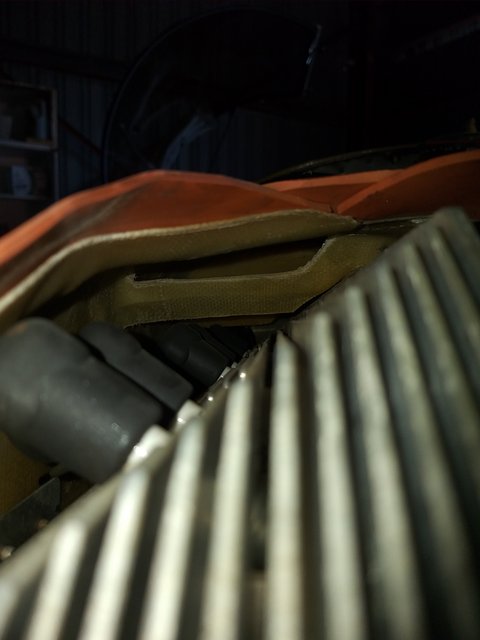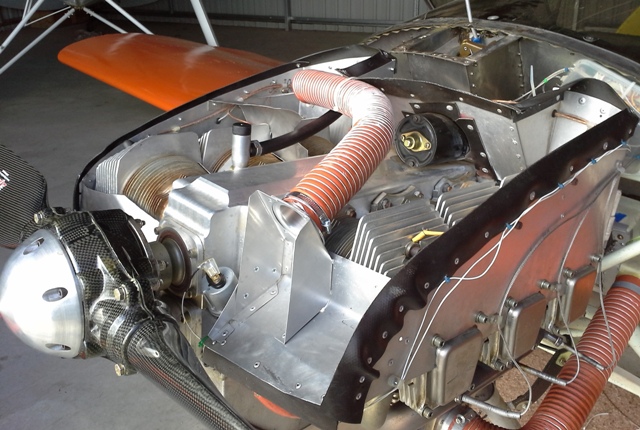Page 1 of 1
Jabiru 3300 Overheating

Posted:
Fri Jul 31, 2020 5:03 pmby buffmaintainer
Hey guys, I'm trying to figure out the engine overheat issue that blew up my old engine. I noticed cylinder no.5 got very hot on the ground, (398F) and once in the air slowly cooled down. Its EGT has stayed constant and pretty much the same as the other cylinders. If you see my last post I pulled the cylinder and heads off and found severe scoring and skirt damage. I didn't run the engine on the ground except to taxi and it was already at 398 before the end of the runway. I would imagine this is consistent with valve failure? Maybe springs?
Re: Jabiru 3300 Overheating

Posted:
Fri Jul 31, 2020 8:36 pmby N111YX
Sorry to hear of your problems.
When attending the large Fly-ins (Oshkosh and Sun n Fun), a problem for me are the long taxi times. I've had to shut down many times and ATC gets excited when they see a prop stopped on an active taxiway and more then once I've had to open the canopy and tell the volunteer that my engine is cooking while waiting for the Tomahawk to taxi 1/2 mile at walking speed before I can cross behind him.
So, we run hot on the ground and anyone that is not monitoring all six cylinders may be causing damage.
On an 80 degree afternoon, I have about 10 minutes maximum to get in the air from a cold start. After landing, I'll need to be shut down in five minutes.
Re: Jabiru 3300 Overheating

Posted:
Fri Jul 31, 2020 10:16 pmby MichaelFarley56
I’m finding I have similar issues as Kip with my Jabiru. If I taxi on the ground for a while my cylinders, especially # 5&6, can get fairly warm and fairly quick. In fact I see a potential issue once the air temp cools off in Ohio where I will need to be careful; I need to wait until the oil hits 120 degrees but not so long that the cylinders cook. I can see where preheating will be essential, or else I’ll have to start the engine and idle for a while, shut down for a while, then restart and go.
Anyway, to answer the original question, I would think that if your cylinders are getting that hot after only a few minutes you may want to do a quick check of your baffling to ensure no big air leaks, make sure your cowling exit ramps and exit area is sufficient, and finally make sure it’s not too lean on the idle. Any of those could help your cylinders get too hot and quickly.
Re: Jabiru 3300 Overheating

Posted:
Sat Aug 01, 2020 2:26 amby sonex892.
I was having high cylinder head temperatures on 5 and 6, Cutting a slot in the top of the deflectors like this fixed it.
Steve
Sonex 892

Re: Jabiru 3300 Overheating

Posted:
Sat Aug 01, 2020 9:23 amby DCASonex
A couple of keys to cooling rear cylinders of a jab 3300 are:
Extend the back end of the plenums down to wrap around backside of cylinders. On #5 if using the fuel pump for a Bing, it should extend far enough to also shield the pump. An extension made of 60-61-T6 aluminum will flex enough to allow removal of the plenum. On #6, seal around the cutout for the engine mount.
Just as important as CHT, and perhaps more so on Jab and CAMit engines is airflow around the steel cylinders. Steel does not conduct heat anywhere near as well as aluminum, and the cylinders walls are thin. Hot spots can develop that cause the oil to break down and scoring results.
Keep the air moving. Baffles that disrupt the airflow may appear to help even out the CHTs but but they reduce the ram air effect that carries cooling air back to the rear cylinders. The plenum can be gradually reduced in cross section while moving to the rear, which helps force a bit more air down between cylinders. Take into account the fact that the incoming air will be spiraling, upward into cylinder #2 and down at cylinder #1. This tends throw air up and over #2, and ram it back to #6. Some folks have the problem where #2 runs hot and # 6 cold for this reason. It also robs the right bank of ram air to rear cylinder #5. Do what you can to smooth the flow.
To complicate matters, too much air running into a vertical wall such as at the back of the plenums can result in an unexpected result where the air is compressed, then rebounds making a pulsed stuttering like effect that reduces flow. I used to encounter this a lot when designing shrink tunnels for packaging, and the effect would be very difficult to observe in flight or even on the ground, Again, do what you can to smooth the flow.
Make sure all the air that comes in, goes through something to pick up heat before it exits. The inter-cylinder gull wing baffles that mount under and between cylinders can be made slightly larger and bent to fit up between the cylinders a bit further.
Just had cataract surgery and hard to see computer, hope not too many typos in this.
David A.
Re: Jabiru 3300 Overheating

Posted:
Sat Aug 01, 2020 7:26 pmby WaiexN143NM
hi all,
We have a gen2 jab 3300, on our legacy waiex. and the sonex metal boxes for cooling tunnels.
What worked well for us was to put a small deflector above the middle cyl rt side. maybe 1/2 x 1/2 in x width of inside box , and deflected maybe 30*degrees, made out of alum. and riveted . also the very back inside of box we riveted in a curved piece of alum, to smoothen out the airflow for better cooling .
we took pics of jab sonexs on flightlines for the front verticle baffles on front entry cylinders. the right is bigger
due to prop rotation and blast.
we have very even cht/ egt’s.
WaiexN143NM
Michael
Re: Jabiru 3300 Overheating

Posted:
Sun Aug 02, 2020 7:17 amby peter anson
My arrangement is so much different to the usual ram air intakes that it might not appear relevant but it does illustrate an important point; because of air swirl caused by the propeller, the right hand intake is nowhere near as efficient as the left hand intake. My Sonex is fitted with a fairly normal plenum intake but I still had problems with #3 and #5 running hotter than the other cylinders so made the changes shown in the photo below.

I have a scoop behind #3 (you can see it just behind the oil filler) so that in effect, the RH intake only cools #1 and #3. About 40% of the LH intake air is ducted to #5 by the scat tube. The remaining 60% if air from the LH intake cools #2, #4 and #6. Cylinder head #6 actually runs a bit too cool and I have been considering restricting air flow to it. I'm in the process of making ground adjustable air outlets so that I can reduce air flow in winter.
Peter
Re: Jabiru 3300 Overheating

Posted:
Sun Aug 02, 2020 7:45 pmby buffmaintainer
Well thanks to the help of You guys and Mr. Radtkey I installed a small baffle to fire air down into the fins of no.5 and no.3. This leveled out the CHTs and she runs amazing now, nice and level now!
I did however get ti have an emergency landing on the test flight after installing the third baffle. I was 2,000 feet up heading to 3F3 and i was trimming the plane out. As it was flying pretty nose high. I released pressure on the stick for a second and the nose shot up a few degrees. I pushed it back down and a pretty nasty, deep vibration started that was enough to shake the compass on the instrument panel. I landed the plane and when I got put heard a creaking noise. The joist failed where the mount attached to the gear tower. I inspected this spot 3 weeks ago and it was fine.. so I got something else to fix. Thank you everyone!
Re: Jabiru 3300 Overheating

Posted:
Sun Aug 02, 2020 10:26 pmby peter anson
Do you have a photograph showing the location of the failure better? It's not clear to me which tube has failed.
Peter
Re: Jabiru 3300 Overheating

Posted:
Sun Aug 02, 2020 10:57 pmby WaiexN143NM
hi peter, all,
thats a nice custom cooling set up peter. like the aerovee full fence baffling.also quite a pick up to carry air to rt side. glad brandon got his cht’s cooled and evened out. sounds like an exciting flight!
i believe he flies 2 sonexs , one td, one trike. i think the engine mount that cracked was on the td.
i will look closer at my weld joints in that area from now on.
brandon maybe you can post a couple pics of your modified baffles. thanks for sharing!
WaiexN143NM
Michael

